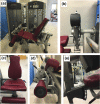Exploratory insights into novel prehabilitative neuromuscular exercise-conditioning in total knee arthroplasty
- PMID: 35672761
- PMCID: PMC9172156
- DOI: 10.1186/s12891-022-05444-0
Exploratory insights into novel prehabilitative neuromuscular exercise-conditioning in total knee arthroplasty
Abstract
Background: Contemporary strategies for prehabilitation and rehabilitation associated with total knee arthroplasty (TKA) surgery have focused on improving joint range-of-motion and function with less emphasis on neuromuscular performance beneficially affecting joint stability. Furthermore, prehabilitation protocols have been found to be too long and generic-in-effect to be considered suitable for routine clinical practice.
Methods: A pragmatic exploratory controlled trial was designed to investigate the efficacy of a novel, acute prehabilitative neuromuscular exercise-conditioning (APNEC) in patients electing TKA. Adults electing unilateral TKA were assessed and randomly allocated to exercise-conditioning (APNEC, n = 15) and usual care (Control, n = 14) from a specialised orthopaedic hospital, in the United Kingdom. APNEC prescribed nine stressful exercise-conditioning sessions for the knee extensors of the surgery leg, accrued over one week (3 sessions·week-1; 36 exercise repetitions in total; machine, gravity-loaded) and directly compared with usual care (no exercise). Prescribed exercise stress ranged between 60%-100% of participant's daily voluntary strength capacity, encompassing purposefully brief muscular activations (≤ 1.5 s). Baseline and follow-up indices of neuromuscular performance focusing on muscle activation capacity (electromechanical delay [EMD], rate of force development [RFD] and peak force [PF]) were measured ipsilaterally using dynamometry and concomitant surface electromyography (m. rectus femoris[RF] and m. vastus lateralis[VL]).
Results: Group mean ipsilateral knee extensor muscular activation capacity (EMDRF [F(3,57) = 53.5; p < 0.001]; EMDVL [F(3,57) = 50.0; p < 0.001]; RFD [F(3,57) = 10.5; p < 0.001]) and strength (PF [F(3,57) = 16.4; p < 0.001]) were significantly increased following APNEC (Cohen's d, 0.5-1.8; 15% to 36% vs. baseline), but unchanged following no exercise control (per protocol, group by time interaction, factorial ANOVA, with repeated measures), with significant retention of gains at 1-week follow-up (p < 0.001).
Conclusions: The exploratory APNEC protocol elicited significant and clinically-relevant improvement and its retention in neuromuscular performance in patients awaiting TKA.
Trial registration: (date and number): clinicaltrial.gov: NCT03113032 (4/04/2017) and ISRCTN75779521 (3/5/2017).
Keywords: Exercise-conditioning; Joint replacement; Neuromuscular; Pre-surgery training; Sensorimotor; Total knee arthroplasty.
© 2022. The Author(s).
Conflict of interest statement
None.
Figures





Similar articles
-
Early initiation of home-based sensori-motor training improves muscle strength, activation and size in patients after knee replacement: a secondary analysis of a controlled clinical trial.BMC Musculoskelet Disord. 2019 May 17;20(1):231. doi: 10.1186/s12891-019-2575-3. BMC Musculoskelet Disord. 2019. PMID: 31101039 Free PMC article. Clinical Trial.
-
Improvement of outcomes with nonconcurrent strength and cardiovascular-endurance rehabilitation conditioning after ACI surgery to the knee.J Sport Rehabil. 2014 Aug;23(3):235-43. doi: 10.1123/jsr.2013-0050. Epub 2014 Mar 12. J Sport Rehabil. 2014. PMID: 24622423 Clinical Trial.
-
Does the addition of hip strengthening exercises improve outcomes following total knee arthroplasty? A study protocol for a randomized trial.BMC Musculoskelet Disord. 2016 Jun 13;17:259. doi: 10.1186/s12891-016-1104-x. BMC Musculoskelet Disord. 2016. PMID: 27295978 Free PMC article. Clinical Trial.
-
The relationship between prescribed pre-operative knee-extensor exercise dosage and effect on knee-extensor strength prior to and following total knee arthroplasty: a systematic review and meta-regression analysis of randomized controlled trials.Osteoarthritis Cartilage. 2020 Nov;28(11):1412-1426. doi: 10.1016/j.joca.2020.08.011. Epub 2020 Sep 2. Osteoarthritis Cartilage. 2020. PMID: 32890744
-
Quadriceps strength in relation to total knee arthroplasty outcomes.Instr Course Lect. 2010;59:119-30. Instr Course Lect. 2010. PMID: 20415375 Review.
Cited by
-
Effects of Resistance Training on Pain, Muscle Strength, and Function in Patients Undergoing Total Knee Arthroplasty: A Systematic Review and Meta-Analysis.J Clin Med. 2025 Jul 14;14(14):4979. doi: 10.3390/jcm14144979. J Clin Med. 2025. PMID: 40725673 Free PMC article. Review.
-
Prehabilitation for Patients Undergoing Elective Foot and Ankle Surgery: A Contemporary Review.Foot Ankle Orthop. 2024 May 28;9(2):24730114241255136. doi: 10.1177/24730114241255136. eCollection 2024 Apr. Foot Ankle Orthop. 2024. PMID: 38812567 Free PMC article. Review. No abstract available.
-
Comparison of Therapeutic Effects of Different Rehabilitation Methods on Patients Undergoing Total Knee Arthroplasty: A Network Meta-Analysis of Randomized Controlled Trials.Orthop Surg. 2025 Feb;17(2):348-360. doi: 10.1111/os.14332. Epub 2025 Jan 8. Orthop Surg. 2025. PMID: 39780331 Free PMC article.
-
Prehabilitation for Patients Undergoing Orthopedic Surgery: A Systematic Review and Meta-analysis.JAMA Netw Open. 2023 Apr 3;6(4):e238050. doi: 10.1001/jamanetworkopen.2023.8050. JAMA Netw Open. 2023. PMID: 37052919 Free PMC article.
References
-
- Ratsepsoo M, Gapeyeva H, Vahtrik D, Aibast H, Ereline J, Haviko T, et al. Knee pain and postural stability in women with gonarthrosis before and six months after unilateral total knee replacement. Acta Kinesiol Univ Tartu. 2011;17:175–186. doi: 10.12697/akut.2011.17.15. - DOI
-
- Skoffer B, Dalgas U, Maribo T, Søballe K, Mechlenburg I. No exacerbation of knee joint pain and effusion following preoperative progressive resistance training in patients scheduled for total knee arthroplasty: secondary analyses from a randomized controlled Trial. J PRMJ. 2018;10(7):687–692. - PubMed
Publication types
MeSH terms
Associated data
LinkOut - more resources
Full Text Sources
Medical
Miscellaneous

